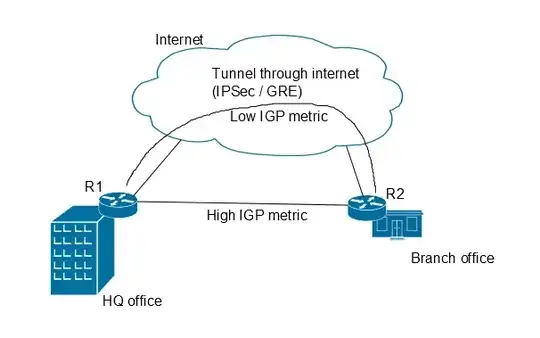I wanted to post my network layout, but I dont have the required reputation. So I have made up a network diagram below:
ISP
/ \
/ \
/ \
HQ------Branch
| |
HQ-PC B-PC
What I am trying to do is to use the WAN Link between HQ and Branch as the back-up link and it must not carry any data unless the link between HQ to ISP or Branch to ISP is down. Meaning it must strictly be only used as a back-up link.
What I have done is using floating static to configure the redundancy. However, it is not quite working out as what I have expected it to be. What I have done are:
1) a default route at the HQ and Branch to the ISP (0.0.0.0 0.0.0.0 NEXT-HOP-IP)
2) static route at ISP to HQ and Branch (HQ/BRANCH-NETWORK-ADDRESS SUBNET-MASK NEXT-HOP-IP)
3) a static(prefered) route at HQ (BRANCH-NETWORK-ADDRESS SUBNET-MASK NEXT-HOP-IP-TO-ISP)
4) a static(prefered) route at Branch (HQ-NETWORK-ADDRESS SUBNET-MASK NEXT-HOP-IP-TO-ISP)
5) a floating static(back-up) route at HQ (BRANCH-NETWORK-ADDRESS SUBNET-MASK NEXT-HOP-IP-TO-HQ-THROUGH-BACKUP-LINK)
6) a floating static(back-up) route at Branch (HQ-NETWORK-ADDRESS SUBNET-MASK NEXT-HOP-IP-TO-BRANCH-THROUGH-BACKUP-LINK)
However, there is a problem. For example, if the link between ISP and HQ is down, when I want to ping from HQ-PC to B-PC, the packet will be successfully sent from HQ-PC to B-PC, but the returning packet from B-PC will be sent to the ISP and not through the back-up link.
So sorry for such a lengthy post, but is there anyone who can help me? If my explanation is unclear, please feel free to query. Thanks in advance
EDIT: Sorry for the confusion, there should not be any routing protocols running with the ISP
